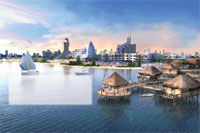Seven million Arabian nights

It would take nearly 19,000 fully-packed super jumbo flights per year to carry guests for the 7.8 million room nights of supply that are confirmed to become available in the GCC’s four- and five-star hotel sector by 2008.
This projection is based on a hotel industry average double occupancy factor of 1.3 people per room and a 533-seat Emirates A380 aircraft, due for delivery from 2006.
The regionwide survey of future upmarket hotel developments was undertaken by the Dubai office of TRI Hospitality Consulting, which identified 80 upcoming hotels and 21,283 future rooms in the Arabian Peninsula – the equivalent of 7,768,295 room nights per annum.
Although the largest single market remains the UAE, with 11,922 rooms due to become available between now and 2008 (9,628 of which are in Dubai alone), the GCC markets expected to make the largest gains are Qatar, with a projected 145 per cent increase in room supply, and Kuwait, with an anticipated 75 per cent increase in room supply.
The markets expected to make the smallest gains in available rooms per annum over their existing supply are Bahrain (23 per cent), and Saudi Arabia (6 per cent) which is somewhat distorted by a very large number of four- and five-star hotels.
“The key word in our survey is ‘confirmed’,” says Peter Goddard, managing director of the Dubai office of TRI, a leading management consultancy in the fields of hotels, tourism, leisure and real estate. “In Dubai, in particular, there is an element of confusion on which hotel developments have been confirmed and which are still in the pre-feasibility stage.’’
He continues: ‘‘On The Palm, Jumeirah, for example, there’s a great deal of buzz surrounding all of the proposed hotel projects. According to our research, nine are confirmed so far.
‘‘While I have every confidence that there will be in the region of 30 to 40 hotel projects when The Palm is complete, TRI’s research has culminated in the most accurate snapshot of the current status of hotel developments in the region.”
According to TRI, the confirmed hotel and resort projects on The Palm, Jumeirah, are the first two phases of Kerzner International’s Atlantis, the Hilton Palace, the Metropolitan, two Radisson SAS properties (one each on The Palm’s Crescent and Trunk), The Fairmont Palm Hotel and Resort, The Fairmont Palm Vacation Club and The Palm Sun Hotel and Resort.
The area of Dubai with the most confirmed hotel developments, however, is Sheikh Zayed Road/Al Barsha, with 12 future hotels confirmed, offering 2,948 rooms.
Included is the five-star, 250-room Armani Hotel in the Burj Dubai development, which is due to open in 2008, and the five-star, 400-room Kempinski Hotel in the Mall of the Emirates, which is due to open in November 2005.
On Dubai’s Jumeirah coast, seven hotel and resort developments were identified as confirmed. Among the six confirmed hotels and resorts north of Dubai Creek, are the five-star, 225-room Park Hyatt at Dubai Creek Golf and Yacht Club and two five-star deluxe properties, a Four Seasons and InterContinental, at Dubai Festival City.
The landmark hotel and resort developments under way in Dubai speak volumes of the tremendous growth of the emirate as an exciting tourist destination, says Goddard.
Elsewhere in the UAE, Abu Dhabi’s confirmed new supply of hotels includes the recently-opened landmark Kempinski-operated Emirates Palace Hotel and Conference Centre, while Fujairah's four new hotel developments include the five-star Kempinski Fujairah Resort and the Robinson Club.
In Qatar, where the hotel sector has been given new impetus by the staging of the Asian Games in 2006, there are 13 confirmed hotel projects with a future supply of 3,118 rooms by 2007. The Pearl Island project alone is reported to have three hotels with 900 rooms opening in 2006. Notable among the other hotels are a five-star, 350-room Grand Hyatt, due to open in 2006, and a five-star, 225-room Four Seasons, to open in 2005.
In Kuwait, where the Kuwait Hotel Owner’s Association has revealed a flurry of applications for new hotel projects – 90 have been received – 16 hotel projects comprising 2,164 rooms are listed by TRI as confirmed.
“Landmark projects for Dubai have acted as a catalyst for the whole region,” says Gavin Samson, TRI’s managing consultant in Dubai. “The other Gulf states are trying to emulate Dubai’s success as they build infrastructure and improve tourist arrivals, or stem the outflow from their own countries.’’
He continues: ‘‘Although the overall tourism objectives are different, there are significant similarities in the strategy, namely the proliferation of mixed-use development and waterfront projects, incorporating. Man-made islands of fantastic designs have also been a strong element.”
Commenting on the growth in mixed-use hotel developments, Samson says: “The rapid expansion of the tourism and real estate markets has been fuelled by an ever-growing number of ambitious mixed-use projects that incorporate significant hotel components.
‘‘These developments are now integral at both a country and regional level as governments seek to diversify their economies through the key growth areas of tourism and real estate.”
